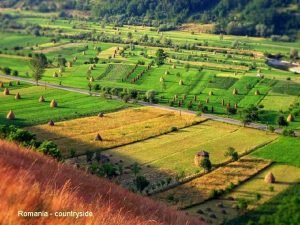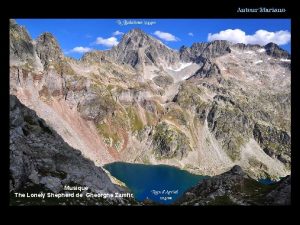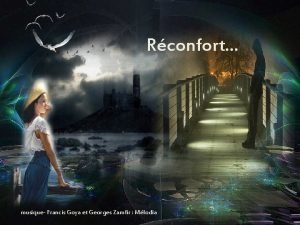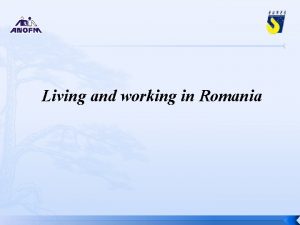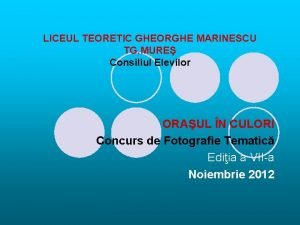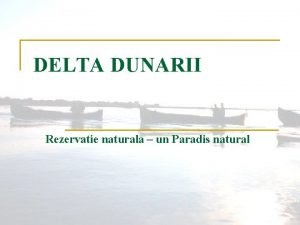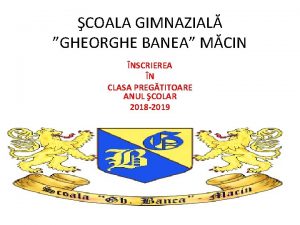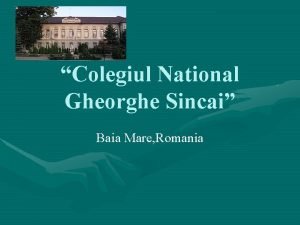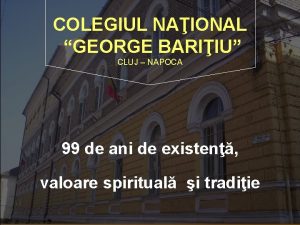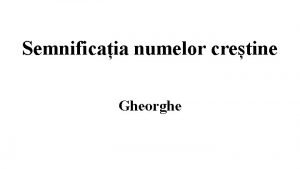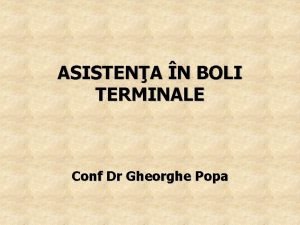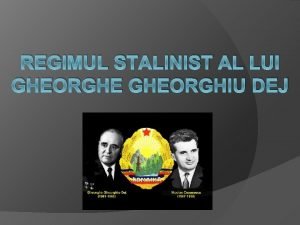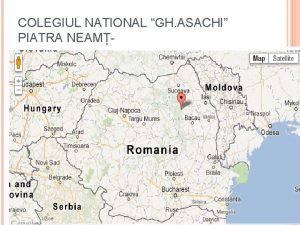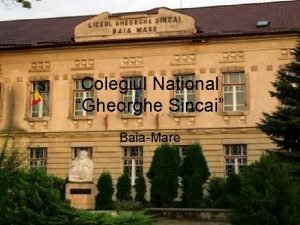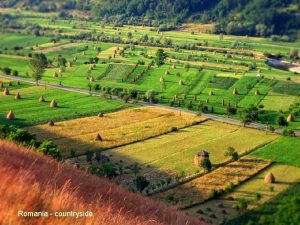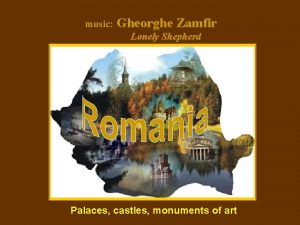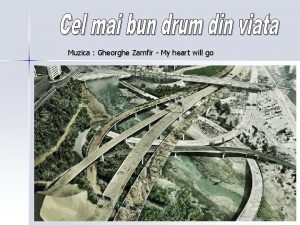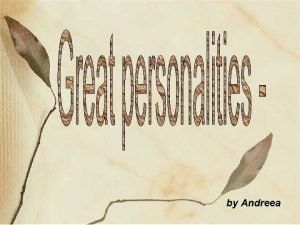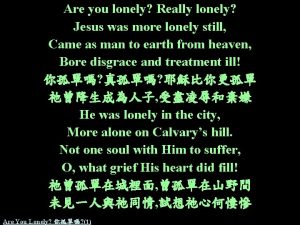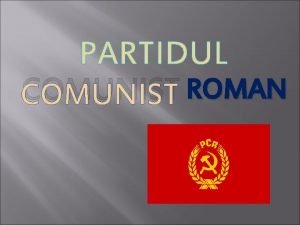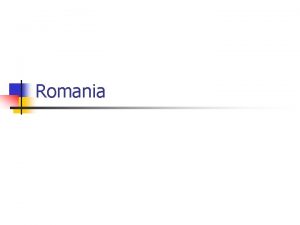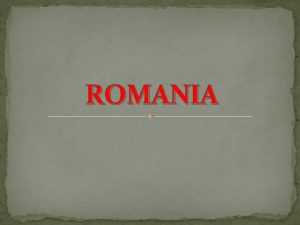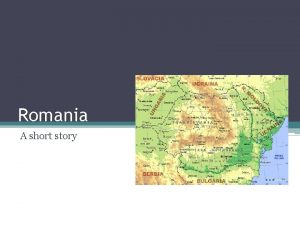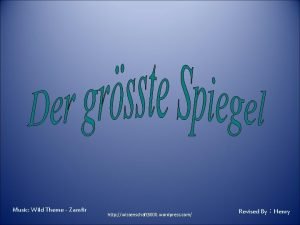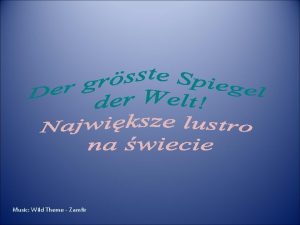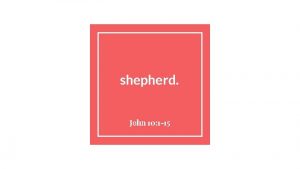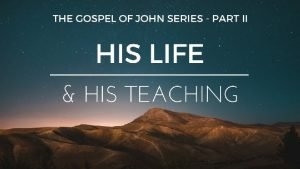ROMANIA Music Gheorghe Zamfir The Lonely Shepherd ROMANIA

























- Slides: 25

ROMANIA Music: Gheorghe Zamfir – The Lonely Shepherd

ROMANIA IN EUROPE

• ROMANIA is a country located at the intersection of Central and Southeastern Europe, bordering on the Black Sea. Romania shares a border with Hungary and Serbia to the west, Ukraine and Moldova to the northeast and east, and Bulgaria to the south. It has 238, 391 square kilometers (92, 043 sq. mi), and a population of 21 330 000 people (2012). GENERAL INFORMATION ABOUT ROMANIA

OFFICIAL NAME: ROMANIA THIS NAME WAS ADOPTED IN 1862, AFTER THE FORMATION OF THE NATIONAL STATE BY THE UNION OF THE TWO ROMANIAN PRINCIPALITIES OF WALLACHIA AND MOLDAVIA IN 1859. NATIONAL FLAG: -(PROPORTION 3/2) THREE EQUAL VERTICAL STRIPES RED, YELLOW, AND BLUE (NEAR TO THE STAFF). IN DECEMBER 1989 THE EMBLEM ON THE YELLOW STRIPE WAS REMOVED. THE TRICOLOR FLAG WAS ADOPTED FOR THE FIRST TIME AS NATIONAL FLAG DURING THE 1848 REVOLUTION IN WALLACHIA.

NATIONAL COAT OF ARMS: An eagle holding a cross in its beak and a sword and a sceptre in its claws as well as the symbols of the five historical provinces: Wallachia, Moldavia, Transylvania (with Crisana and Maramures), Banat and Dobrudja. FORM OF GOVERNMENT: Republic December 1 NATIONAL DAY: December 1 was adopted as National Day in 1990, being the day of celebration of the Great Assembly of Alba Iulia which voted for the union of Transylvania with Romania and which symbolize the union of all Romanians within a single state and the achievement of the unity of Romanian national state.

CAPITAL BUCHAREST

STATE ANTHEM (since 1990): “AWAKEN THEE, ROMANIAN!” OFFICIAL LANGUAGE The Romanian language, which is the mother tongue of around 90% of the country's population. The eastern most representative of the family of Romance languages, Romanian descends directly from the Latin. The citizens belonging to ethnic minorities may freely use their mother tongue in schools, administration, justice, the media, and culture. CURRENCY 1 leu (plural - lei) = 100 bani (singular ban). The domestic convertibility of the leu was introduced in November 1991.

Geography and Climate Romania's terrain is distributed roughly equally between mountainous, hilly and lowland territories. The Carpathian Mountains dominate the center of Romania's geographical diversity has led to an accompanying diversity of flora and fauna. Romania has a climate that is temperate and continental, with four distinct seasons. The average annual temperature is 11 °C (52 °F) in the south and 8 °C (46 °F) in the north.


Romanian folklore is the best preserved, most varied and traditional in Europe. The tasteful beauty of the regional costumes can be seen throughout Romania. The costumes reflects ethnic identity and documents the historical and artistic values of the Romanian people. • TRADITIONAL ROMANIAN FOLK COSTUME

CERASU PRAHOVA COUNTY, ROMANIA

Cerasu Commune is a typically submontane area with a population of over 5. 000 people, situated in the North-West of Prahova County at approximately 750 m altitude, 50 km away from the administrative city of Ploiesti. It has 6 villages: Cerasu, the Centre and administrative village, Valea Borului, Valea Bradetului, Valea Tocii, Valea Lespezii and Slon.

• GENERAL INFORMATION ABOUT CERAȘU Cerasu is surrounded by a variety of landforms starting with the hills that guard our village and carrying on with the mountain peaks that dominate its northern side: Clabucet Mountain (1474 m), Virful lui Crai (1485 m) and Tataru (1476 m) – all conferring a quite picturesque air to our land. Cerasu is crossed by Drajna Creek that flows into the Teleajen River, springing right underneath Vârful lui Crai. You can see the amazing trout swimming in its waters, a tasty delicacy and an attraction for tourists. There are other creeks, too, crossing our village all year round: Valea Slonului, Valea Carpenisului, Valea Lespezii - during the rainy season their shallow waters flood causing land slide and erosion. There are useful mineral resources in the region, mostly found in the Sub Carpathian area. These are used in the local economy in constructions: gypsum, sand pebbles (ballast). There also two sulfurous springs in Slon and in Valea Lespezii, which represent a great medical potential for the area. When you visit our village, you can enjoy the fresh mountain air: from Slon Village you can go backpacking to the Teleajen Sub Carpahtianas along Drajna River, up to Tataru Mountains and Grohotisului Hill and see the medieval fortresses La Cinga (9 th century) and Tabla Butii (13 th – 14 th centuries).

There is also a wild pigs and brown bears natural reservation that can be visited if you go to Valea Borului Village. Tourists who come to visit us usually check in at Pensiunea Cerasu (3 stars boarding house), which is also situated in Valea Borului. Our community dates back in historical times and the name “Slon” is certified before the 8 th century, continuing its existence up until the 12 th century, although it had to put up with wars and attacks from other people attested at the time in the area. The two medieval fortresses, La Ciuga and Tabla Butii, are ancient witnesses to the history of our community and its continuity on the land. Cerasu Commune was twinned with Kowala – Radom from Poland, and with Meryer, from France. It is a member in The Intercommunity Association for Touristic Promotion and Development in the Valea Teleajenului area. It is also cofounder of The Association for Mountain Tourism Prahova. Slon

CERAȘU TOWN HALL

ST. NICHOLAS CHURCH

SCHOOLS AND KINDERGARTENS

CULTURAL CENTERS



LIBRARY

Ethnographic Museum

Cultural Foundation Tr. Traian Cepoiu

Tabla Butii Festivities ( 6 th of August) - to honour the memory of our heroes

Autumn Festival
 Gheorghe zamfir biografie
Gheorghe zamfir biografie The lonely shepherd
The lonely shepherd Gheorghe zamfir lonely shepferd
Gheorghe zamfir lonely shepferd Balaitous mariano
Balaitous mariano The lonely shepherd histoire
The lonely shepherd histoire Online music portfolio
Online music portfolio Nae zamfir
Nae zamfir A music that employs electronic musical instruments
A music that employs electronic musical instruments Uged ilocano
Uged ilocano Vocal music of the romantic period
Vocal music of the romantic period Rhythm music appreciation
Rhythm music appreciation Liceul gheorghe marinescu
Liceul gheorghe marinescu Informatii delta dunarii
Informatii delta dunarii Scoala gheorghe banea macin
Scoala gheorghe banea macin Laurentiu dimitriu iasi
Laurentiu dimitriu iasi Monica dascalu upb
Monica dascalu upb Colegiul gheorghe sincai baia mare
Colegiul gheorghe sincai baia mare Gheorghe sincai
Gheorghe sincai Colegiul baritiu cluj
Colegiul baritiu cluj Semnificatia numelui georgeta
Semnificatia numelui georgeta Gheorghe tecuci
Gheorghe tecuci Asistena
Asistena Gheorghe tecuci
Gheorghe tecuci Regimul stalinist gheorghe gheorghiu dej
Regimul stalinist gheorghe gheorghiu dej Colegiul national gheorghe asachi
Colegiul national gheorghe asachi Liceul gheorghe sincai baia mare
Liceul gheorghe sincai baia mare


